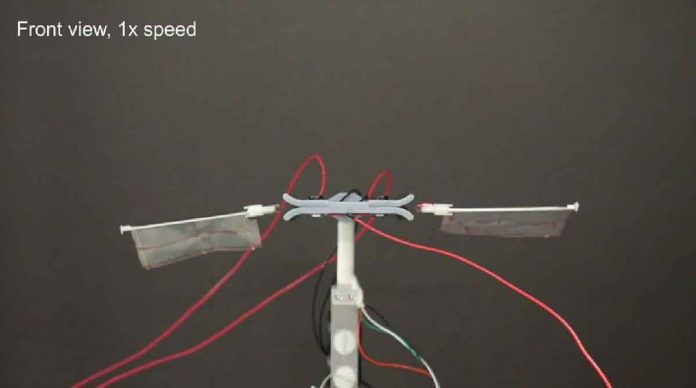University of Bristol scientists have made a groundbreaking discovery in the field of robotics, developing a revolutionary drive system for flapping wing autonomous robots.
The new method, called electromechanical zipping, eliminates the need for conventional motors and gears, opening up a world of possibilities for the future of micro flying robots.
The study, published in Science Robotics, has the potential to create smaller, lighter, and more efficient robots for environmental monitoring, search and rescue missions, and deployment in hazardous environments.
Embracing Nature’s Ingenious Design
Taking inspiration from the flight mechanics of bees and other flying insects, the scientists from Bristol’s Faculty of Engineering devised the Liquid-amplified Zipping Actuator (LAZA) system.
Unlike traditional micro flying robots that rely on motors and gears for wing movement, the LAZA system employs a direct-drive artificial muscle system, mimicking the simplicity and effectiveness of nature’s design.
Flapping Robots on the Rise
Up until now, micro flying robots utilized complex transmission systems involving motors and gears to achieve wing motion.
However, this complexity added weight and undesired dynamic effects to the robots, limiting their efficiency and flight capabilities.
With the introduction of LAZA, the flapping mechanism is streamlined, enabling the miniaturization of robots to the size of insects.
This breakthrough could revolutionize various industries, from surveillance and environmental monitoring to search and rescue missions.
Power in Lightweight Wings
One of the most impressive aspects of the LAZA system is its ability to generate immense power while maintaining a lightweight structure.
In fact, the researchers found that a pair of LAZA-powered flapping wings produced more power compared to the insect muscles of the same weight.
This newfound power potential allows the robots to fly across a room at an astonishing speed of 18 body lengths per second.
Endurance for Long-Haul Flights
To be practical in real-world applications, flapping robots need to demonstrate endurance over extended periods.
The University of Bristol scientists were up to the challenge, showcasing how the LAZA system could deliver consistent flapping motion over more than one million cycles.
This remarkable durability is a critical feature for creating flapping robots capable of undertaking long-haul flights, making them suitable for various missions, including surveillance and data gathering.
A Fundamental Building Block
The scientific community has high expectations for the Liquid-amplified Zipping Actuator.
Researchers believe it will serve as a fundamental building block for a wide array of autonomous, insect-like flying robots.
By eliminating the need for traditional motors and gears, the LAZA system simplifies the overall design of these robots, making them easier to manufacture, lighter in weight, and more energy-efficient.
Shaping the Future of Robotics
The implications of this breakthrough are immense. With the development of the LAZA system, researchers at the University of Bristol have opened up new possibilities for the field of robotics.
These flapping wing robots could play a vital role in various applications, from monitoring and mapping remote regions to performing intricate tasks in environments hazardous to humans.
As the technology advances, we can expect to see even more innovative uses for these tiny yet powerful robots, shaping the future of automation and exploration.
In conclusion, the University of Bristol scientists have achieved a remarkable feat in the realm of robotics by introducing the Liquid-amplified Zipping Actuator system.
By drawing inspiration from nature and eliminating the need for conventional motors and gears, they have paved the way for the development of smaller, lighter, and more efficient micro flying robots.
The potential applications of these flapping wing robots are vast, and as the technology evolves, we can anticipate even more groundbreaking advancements in the field of robotics and automation.

